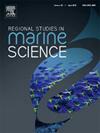Are chrysene and manganese ecotoxic to meiobenthic copepods? Assessment through integrated quantitative/taxonomic tools and in silico modeling
IF 2.1
4区 环境科学与生态学
Q3 ECOLOGY
引用次数: 0
Abstract
The current study examined the effects of two pollutants, chrysene, and manganese, on the structure and diversity of free-living marine copepods along the Jeddah coast of Saudi Arabia. The experimental design included manganese (hereafter Mn) at two concentrations (Mn1 = 100 μg/g and Mn2 = 200 μg/g) and chrysene (hereafter CHR) at two concentrations (CHR1 = 1 μg/g and CHR2 = 2 μg/g), both individually and in combinations. The findings indicated a reduction in the abundance of all meiobenthic taxa following exposure to these pollutants. Notably, there was a significant decrease in numbers and species diversity among the copepods, with the greatest effects observed after exposure to treatments Mn2, Chr2/Mn2, and Chr1/Mn2. This pattern was confirmed through univariate indices and multivariate analyses. The research resulted in establishing a list of vulnerable species affected by chrysene and/or manganese, which could inform future governmental policy considerations. This kind of information is crucial for mitigating risks to human health. Additionally, the results underscored the harmful effects of chrysene and manganese on meiobenthic copepods, as supported by computational in silico modeling.
甲苯和锰对中苯桡足类有生态毒性吗?通过综合定量/分类学工具和计算机建模进行评估
目前的研究调查了两种污染物——氯和锰——对沙特阿拉伯吉达海岸自由生活的海洋桡足类动物的结构和多样性的影响。实验设计包括锰(以下简称Mn)两种浓度(Mn1 = 100 μg和Mn2 = 200 μg/g)和甲苯(以下简称CHR)两种浓度(CHR1 = 1 μg和CHR2 = 2 μg/g)单独和组合。研究结果表明,暴露于这些污染物后,所有低密度有机物分类群的丰度都有所减少。其中,Mn2、Chr2/Mn2和Chr1/Mn2处理对桡足类数量和物种多样性的影响最大。通过单因素指数和多因素分析证实了这一模式。这项研究的结果是建立了一份受氯化物和/或锰影响的脆弱物种名单,这可以为未来的政府政策考虑提供信息。这类信息对于减轻对人类健康的风险至关重要。此外,研究结果强调了铬和锰对低苯类桡足动物的有害影响,这一点得到了计算机模拟的支持。
本文章由计算机程序翻译,如有差异,请以英文原文为准。
求助全文
约1分钟内获得全文
求助全文
来源期刊

Regional Studies in Marine Science
Agricultural and Biological Sciences-Ecology, Evolution, Behavior and Systematics
CiteScore
3.90
自引率
4.80%
发文量
336
审稿时长
69 days
期刊介绍:
REGIONAL STUDIES IN MARINE SCIENCE will publish scientifically sound papers on regional aspects of maritime and marine resources in estuaries, coastal zones, continental shelf, the seas and oceans.
 求助内容:
求助内容: 应助结果提醒方式:
应助结果提醒方式:


